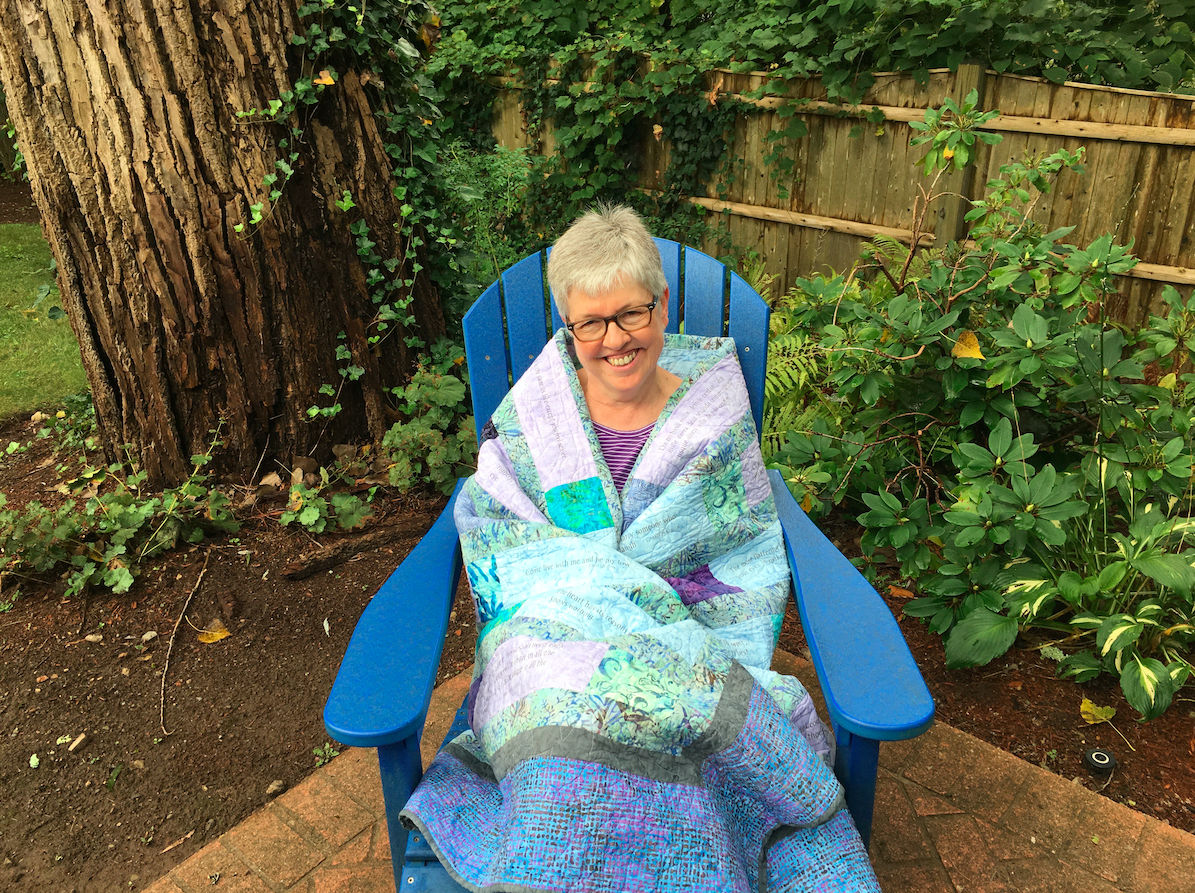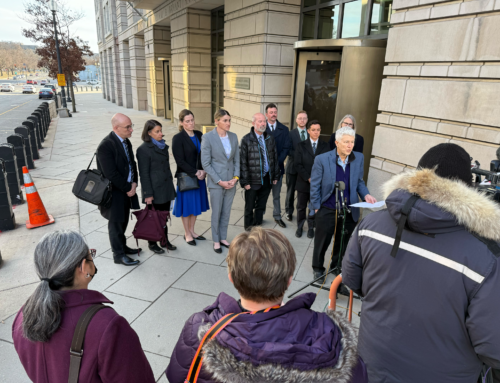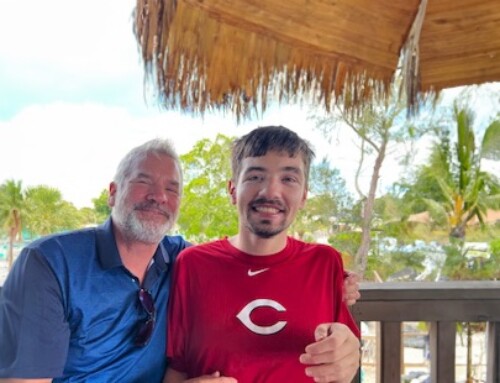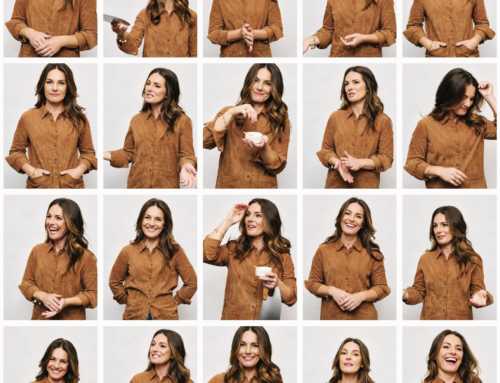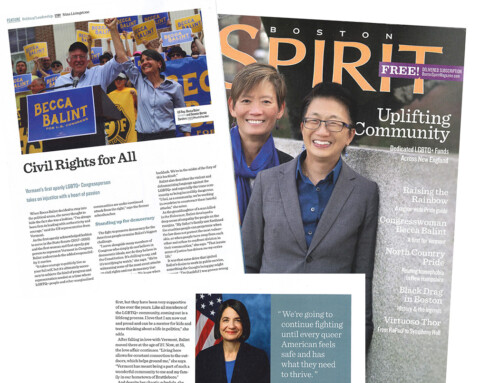Meet Liz Gray, owner of LizBiz, and discover the warmest quilts for winter
Dec 9, 2021
When I walked into the artist’s co-op
…it was as if a field of flowers had been projected upon the wall. It was a quilt, as magnificent as any painting. Luminous golds and blues dominated the design. I stood there and studied the trace of threads that held the tapestry intact.
“Isn’t it beautiful?” said the man, with a 5 o’clock shadow and striking blue eyes, holding a large canvas.
“Yes,” was all I could say. It had taken my breath away.
I moved on to the notecards, handmade with fabrics of all kinds. I touched them but found myself glancing back at the quilt. At that time in my life, it was all about the visuals. I loved and looked for the details in design.
I was teaching myself to memorize the colors as my tunnel vision began to narrow the field, eventually leaving me blind. With my eyesight gone, my appreciation of all things tactile increased. I have always loved fine fabrics. I trace their lines, touching the textures in quilts, scarves, cards, and an array of clothing. The tactile approach somehow gives me the independence of making astute decisions about what I want to wear, what I choose to wrap myself in, such as the comfort and beauty of the blankets and quilts I’ve collected along the way.
The details that Liz Gray describes in her work — quilts, cards, books, scarves and rugs — brings me back to that memorable gold and blue quilt.

Image Credit: Lizbiz
Nina Livingstone: Having traveled and lived in various parts of the world, where do you feel most comfortable when doing your work?
Liz Gray: I am comfortable and creative in any place where I can create a sense of sanctuary, of home. I like to be surrounded by pieces of my history, by color, by order, by windows that provide lots of light. If I had unlimited funds, I would have a home near the ocean in Provincetown and an apartment with a terrace in Italy — both of those places, which are abundant with art and architecture, always put me in a creative frame of mind.
NL: You design and make exquisite quilts, scarves, rugs, handmade books, and cards … can you outline your process for creating?
LG: Many of my ideas are inspired by color and design. I recently made a quilt for a friend whose favorite color is green. Though I used a simple pattern, I chose a wide variety of fabrics from a single designer. There were many different greens from which to choose, and the fun was in arranging them to harmonize with each other. In addition, I chose fabrics that included bits of blue and lavender to complement the greens and make them stand out. I also get ideas from other quilters, from art exhibits, and from nature. I will often make something to challenge myself and learn a new skill. I’m always taking classes or attending workshops!
NL: And how do you proceed from the inspiration?
LG: I usually have more than one project going at a time—a scarf or a hand-sewing project that I can take with me on a road trip, a quilt commission, a class assignment, a new idea, a baby gift. However, I am good about completing my projects—I don’t have too many UFOs (unfinished objects) hanging around. I like the feeling of satisfaction that comes from completion; it frees me up to try new things.
NL: Your career as a teacher and librarian spanned almost four decades. How did learning to quilt, knit, and create your art fit into your schedule?
LG: My mother taught me to knit and needlepoint when I broke my leg at age 10, and in college I learned to crochet. After I graduated, I took a long hiatus from creating. In the early 1990s I got the itch again and learned to make jewelry, and then I was seduced by the many new and interesting yarns on the market and started knitting again. Over the last ten years of my career as a teacher/librarian, the activities that soothed my soul (other than reading & movies, my other favorite pastimes) were creative ones—I started to live for the weekends and opportunities to make things. About a year before I retired, I took a quilting class and that has become my biggest passion. In addition to making quilts, I collect antique and vintage quilts and am studying to be a quilt appraiser.

Image Credit: Lizbiz
NL: Can you describe your quilts and other creations and what makes them special?
LG: My quilts are characterized by a bold use of color and a sort of exuberant orderliness, and I prefer a modern look to a traditional one. That said, I still rely on many traditional patterns and try to reinterpret them in a more contemporary style. The cards and books I make are driven by either a use (I made a special book in which to record my marriage contract, for example) or because I am inspired by specific materials like old catalog cards, old maps, and stamps. My scarves are soft and cuddly—that’s very important—and I’m particularly fond of color-blocked designs.
NL: Do you do custom work and if so, what does that process look like?
LG: I do custom work for quilts, particularly of full and queen-size quilts. I interview the client to determine what colors and styles they have in mind, and together we come up with a plan. I find it extremely helpful to see pictures of quilts—either mine or someone else’s—that the client likes and dislikes.
NL: Your work is all done by hand … much of it delicate. Are there tips you’ve picked up to protect your hands? For example, I read braille and this tactile method, while indispensable to me, requires breaks so I can rest my hands and fingers to avoid a repetitive injury.
LG: I am fortunate to not be afflicted by arthritis, so I don’t have any hand issues so far, but I am very aware of the effects of quilting on my posture. I take frequent stretch breaks and do exercises to keep my shoulders and back in good condition. Hand sewing can also be quite meditative. I hand bind all my quilts and really enjoy that last step in the process; it gives me a chance to appreciate and look closely at the work I have created, which I am less likely to do when I use a sewing machine.
NL: What are your favorite colors?
LG: Blue, purple, and green are my favorite colors, particularly in combination, and I especially love blue and white together. However, I make quilts using a range of colors because I know that others have different preferences and it’s fun to play with a variety of colors to see how they interact. I once made a quilt with lots of reds that I was planning to trim in white, but when I accidentally laid it on top of a piece of lavender fabric—which I had not considered as an option—I was struck by how great they looked together. It was such a pleasant surprise! (see photo below)

Image Credit: Lizbiz
NL: We live in a “disposable society,” where many things are simply thrown away. How do you make use of pre-loved items in your creative process?
LG: I upcycle cotton clothing into my fabric collection, and I hunt thrift stores for old cashmere sweaters which I then cut into the “yarn” I use for knitting rugs. Vintage sheets make great quilt backs. Buttons, stamps, keys, shells, matchbook covers, postcards—all these things can be incorporated into other art forms. I also repair and finish vintage quilt tops that were never completed.
NL: Do you believe people are more drawn to an item that has been created from something else?
LG: I think many people like not being wasteful and find art created from repurposed materials to be appealing.
NL: I know I was drawn to cozy, warm and comforting things during the height of the pandemic last winter. Did you find there was a change in your business during this time?
LG: I certainly made more quilts than usual during the pandemic. My average is 10 a year, and in 2020 I made 14, plus several scarves and many cards. Quilts are comforting for so many reasons, and if cared for properly they are durable and long-lasting.
NL: What fabrics do you like working with most, and why?
LG: My favorite fabric is cotton. It comes in many varieties—batik, gingham, lawn, flannel, to name just a few—and offers the most flexibility to a quilter. It’s also forgiving and long-lasting. Silk, satin, and fleece feel good to the touch, but they are challenging to sew.
NL: Most people go by visuals—color and design. In my case, without sight I would probably instead detect the labor behind the stitching, cut, and fabric. Do you ever close your eyes just to feel your finished product?
LG: Definitely! Most of the things I make have a tactile quality—it’s one of the reasons I enjoy making them.
NL: Can you finish this sentence? Liz Biz is unique because ….
LG: …. it presents my vision, and there’s no one else who draws on my particular combination of experiences. Of course, you can say that about any artist!
This interview was originally published online at New England Doorstep Market on Dec 9th, 2021.


